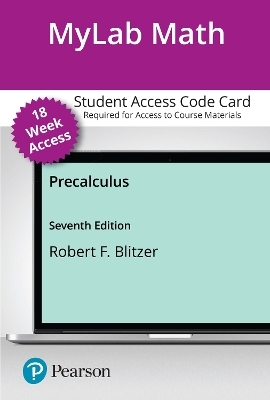
MyLab Math with Pearson eText Access Code for Precalculus
Pearson (Hersteller)
978-0-13-732168-1 (ISBN)
- Titel z.Zt. nicht lieferbar
- Versandkostenfrei
- Auch auf Rechnung
- Artikel merken
Learn how our world is profoundly mathematical
Bob Blitzer continues to support and inspire students with his engaging approach, making this a series that is beloved year after year by students and instructors alike. Blitzer's unique background in mathematics and behavioral science presents readers with a wide range of applications, drawn from pop culture and up-to-date references, that appeal to students of all majors and connect math to their lives.
Blitzer's updated MyLab® Math course offers just-in-time support with Integrated Review and a full suite of materials that support corequisite courses, regardless of format or structure. New gradable GeoGebra Graphing Exercises encourage more of a paper-pencil experience, while a larger selection of Interactive Figures helps students visualize mathematical concepts.
Personalize learning with MyLabMath with Pearson eText
This flexible digital platform combines unrivaled content, online assessments, and customizable features to personalize learning and improve results.
Pearson eText is an easy-to-use digital textbook available within MyLab that lets you read, highlight, and take notes all in one place.
NOTE: Before purchasing, check with your instructor to confirm the correct ISBN. Several versions of the MyLab® and Mastering® platforms exist for each title, and registrations are not transferable. To register for and use MyLab or Mastering, you may also need a Course ID, which your instructor will provide.
Used books, rentals, and purchases made outside of Pearson
If purchasing or renting from companies other than Pearson, the access codes for the MyLab platform may not be included, may be incorrect, or may be previously redeemed. Check with the seller before completing your purchase.
About our author Bob Blitzer is a native of Manhattan and received a Bachelor of Arts degree with dual majors in mathematics and psychology (minor: English literature) from the City College of New York. His unusual combination of academic interests led him toward a Master of Arts in mathematics from the University of Miami and a doctorate in behavioral sciences from Nova University. Bob's love for teaching mathematics was nourished for nearly 30 years at Miami Dade College, where he received numerous teaching awards, including Innovator of the Year from the League for Innovations in the Community College and an endowed chair based on excellence in the classroom. In addition to Precalculus, Bob has written textbooks covering developmental mathematics, introductory algebra, intermediate algebra, trigonometry, college algebra, algebra & trigonometry, and liberal arts mathematics, all published by Pearson. When not secluded in his Northern California writer's cabin, Bob can be found hiking the beaches and trails of Point Reyes National Seashore and tending to the chores required by his beloved entourage of horses, chickens, and irritable roosters.
P. Prerequisites: Fundamental Concepts of Algebra
P.1 Algebraic Expressions, Mathematical Models, and Real Numbers
P.2 Exponents and Scientific Notation
P.3 Radicals and Rational Exponents
P.4 Polynomials
P.5 Factoring Polynomials
P.6 Rational Expressions
P.7 Equations
P.8 Modeling with Equations
P.9 Linear Inequalities and Absolute Value Inequalities
Summary, Review, and Test
Review Exercises
Chapter P Test
1. Functions and Graphs
1.1 Graphs and Graphing Utilities
1.2 Basics of Functions and Their Graphs
1.3 More on Functions and Their Graphs
1.4 Linear Functions and Slope
1.5 More on Slope
1.6 Transformations of Functions
1.7 Combinations of Functions; Composite Functions
1.8 Inverse Functions
1.9 Distance and Midpoint Formulas; Circles
1.10 Modeling with Functions
2. Polynomial and Rational Functions
2.1 Complex Numbers
2.2 Quadratic Functions
2.3 Polynomial Functions and Their Graphs
2.4 Dividing Polynomials; Remainder and Factor Theorems
2.5 Zeros of Polynomial Functions
2.6 Rational Functions and Their Graphs
2.7 Polynomial and Rational Inequalities
2.8 Modeling Using Variation
3. Exponential and Logarithmic Functions
3.1 Exponential Functions
3.2 Logarithmic Functions
3.3 Properties of Logarithms
3.4 Exponential and Logarithmic Equations
3.5 Exponential Growth and Decay; Modeling Data
4. Trigonometric Functions
4.1 Angles and Radian Measure
4.2 Trigonometric Functions: The Unit Circle
4.3 Right Triangle Trigonometry
4.4 Trigonometric Functions of Any Angle
4.5 Graphs of Sine and Cosine Functions
4.6 Graphs of Other Trigonometric Functions
4.7 Inverse Trigonometric Functions
4.8 Applications of Trigonometric Functions
5. Analytic Trigonometry
5.1 Verifying Trigonometric Identities
5.2 Sum and Difference Formulas
5.3 Double-Angle, Power-Reducing, and Half-Angle Formulas
5.4 Product-to-Sum and Sum-to-Product Formulas
5.5 Trigonometric Equations
6. Additional Topics in Trigonometry
6.1 The Law of Sines
6.2 The Law of Cosines
6.3 Polar Coordinates
6.4 Graphs of Polar Equations
6.5 Complex Numbers in Polar Form; DeMoivre's Theorem
6.6 Vectors
6.7 The Dot Product
7. Systems of Equations and Inequalities
7.1 Systems of Linear Equations in Two Variables
7.2 Systems of Linear Equations in Three Variables
7.3 Partial Fractions
7.4 Systems of Nonlinear Equations in Two Variables
7.5 Systems of Inequalities
7.6 Linear Programming
8. Matrices and Determinants
8.1 Matrix Solutions to Linear Systems
8.2 Inconsistent and Dependent Systems and Their Applications
8.3 Matrix Operations and Their Applications
8.4 Multiplicative Inverses of Matrices and Matrix Equations
8.5 Determinants and Cramer's Rule
9. Conic Sections and Analytic Geometry
9.1 The Ellipse
9.2 The Hyperbola
9.3 The Parabola
9.4 Rotation of Axes
9.5 Parametric Equations
9.6 Conic Sections in Polar Coordinates
10. Sequences, Induction, and Probability
10.1 Sequences and Summation Notation
10.2 Arithmetic Sequences
10.3 Geometric Sequences and Series
10.4 Mathematical Induction
10.5 The Binomial Theorem
10.6 Counting Principles, Permutations, and Combinations
10.7 Probability
11. Introduction to Calculus
11.1 Finding Limits Using Tables and Graphs
11.2 Finding Limits Using Properties of Limits
11.3 Limits and Continuity
11.4 Introduction to Derivatives
| Erscheint lt. Verlag | 23.3.2022 |
|---|---|
| Sprache | englisch |
| Gewicht | 20 g |
| Themenwelt | Mathematik / Informatik ► Mathematik |
| ISBN-10 | 0-13-732168-6 / 0137321686 |
| ISBN-13 | 978-0-13-732168-1 / 9780137321681 |
| Zustand | Neuware |
| Informationen gemäß Produktsicherheitsverordnung (GPSR) | |
| Haben Sie eine Frage zum Produkt? |